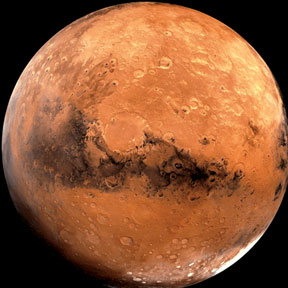Closing in on Mars
 Humans will never get over their fascination with Mars, the Red
Planet. For a start, it is the most Earth-like planet out there, if we
dismiss Earth’s real twin Venus which has unbearable conditions. Humans will never get over their fascination with Mars, the Red
Planet. For a start, it is the most Earth-like planet out there, if we
dismiss Earth’s real twin Venus which has unbearable conditions.
Mars is half in size, but a day on the Red Planet is also nearly 24
hours.
Mars is currently in the news due to several factors. The main reason
is the spectacular success of NASA’s unmanned missions to Mars which are
conducting surface expeditions and experiments as we write. NASA updates
us almost every day on the activities of the Curiosity mission, which
has already gathered evidence that Mars’ atmosphere was once dense
enough to support liquid water on the surface. The Martian atmosphere is
still active to some extent. With that comes the tantalising possibility
that Mars may have harboured life at one stage or could be hosting
rudimentary forms of life even now.
That is just one more reason why Mars should be the next destination
for a manned space mission. However, with current propulsion
technologies, that is a tall order - it will take a minimum of four
years.
 That may not seem bad, but we have to factor in how two or more
people can spend four years scooped up in a metal tube. A faster journey
will be much appreciated. That may not seem bad, but we have to factor in how two or more
people can spend four years scooped up in a metal tube. A faster journey
will be much appreciated.
The answer could be nuclear energy. Many space probes are already
nuclear powered (in conjunction with solar power) including Curiosity
itself. However, we are talking about a different ‘take’ on nuclear
energy - nuclear fusion, the safer, zero-emission alternative to nuclear
fission, the current technology a la Hiroshima, Chernobyl and Fukushima.
Nuclear fusion is the process that powers the Sun - a reaction that will
go on for another 4.5 billion years.
A research group at the University of Washington, funded by NASA, is
about to build a fusion-powered rocket. This rocket, if it can be
successfully built, could propel a manned spacecraft to Mars in just 30
days - just one month and even other planets could get much closer.
Indeed, if we do not find a faster method of space travel, even the
nearest planet outside the Solar System will be a staggering 200,000
years away..
Fusion is an ideal method of rocket propulsion, as fusion fuel has
immense energy density - seven million times denser than conventional
rocket fuel. The weight and expense of fuel are the biggest barriers to
interplanetary/interstellar space travel.
The UW team has spent the last few years developing and testing each
of the various stages of a fusion rocket. Now it is time to bring these
isolated tests together to produce an actual fusion rocket. To succeed,
Slough and co will need to create a fusion process that generates more
power than it requires to get the fusion reaction started - a feat that,
despite billions of dollars of research, has eluded the world’s finest
scientists for more than 60 years.
Description
The website ExtremeTech has a description of what the new method is
all about: “The UW fusion rocket design is mechanically simple and also
ingenious. In essence, there’s a pellet of deuterium-tritium (hydrogen
isotopes; the usual fuel used with fusion), and some large metal rings
made of lithium. When the pellet is in the right place, flowing through
the combustion chamber towards the exhaust, a huge magnetic field is
triggered, causing the metal rings to slam closed around the pellet of
fuel.
These rings then implode with such pressure that the fuel compresses
into fusion - much in the same way that a car compresses diesel into
combustion. The fusion causes a massive explosion, ejecting the metal
rings out of the rocket at 108,000 kmh, generating thrust.
This reaction would be repeated every 10 seconds, eventually
accelerating the rocket to somewhere around 200,000 miles per hour -
about 10 times the speed of Curiosity as it hurtled through space from
Earth to Mars.”
If the team at UW and other scientists around the world overcome this
obstacle, not only will Mars be closer, but the Earth itself will also
benefit by having a sustainable power source. A fusion process must work
reliably and be capable of generating more thermal energy than the
electrical energy required to start the fusion reaction. The moment that
problem is overcome, fusion will be the way to go - to Mars and planets
beyond.
Reactor
Apart from the team at UW, our best hope lies in the work that ITER
(International Thermonuclear Experimental Reactor) is doing. A fusion
reactor project backed by US, Russia, France, India, Korea, China, Japan
and the EU, the ITER is on course to deliver reliable, safe nuclear
fusion power. However, it could take another 20 years for the technology
to become commercially viable. In the meantime, there is nothing like
working feverishly to achieve this ultimate goal.
Fusion power or not, both Governments and private sector
organisations are planning manned missions to Mars. Mars One is one such
private sector initiative which plans a permanent settlement on Mars -
it has no plans to bring the astronauts back to Earth. They hope to
accomplish a manned mission to Mars by 2023, which is just 10 years
away. A bit ambitious then, but certainly not impossible.
Mars is an exciting prospect because it is the only planet in the
Solar System that could potentially be “terraformed” - in other words,
made into an Earth-like planet. It will take hundreds of years with
current technologies, but it is well worth a shot. Mars could be our
second home and a base from which we could venture out to other worlds.
As for critics who say that exploring Mars is a huge waste of money,
the more we learn about Mars and other planets, the more we learn about
the Earth itself. Humans are curious by nature - we are born to explore.
If that instinct gives us a chance to venture to other worlds, humankind
will benefit in no small measure. After all, the Earth is not going to
last forever. It will be great to have other homes around the Universe
when that happens. |


